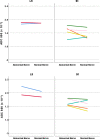Identifying lumbosacral plexus nerve root abnormalities in patients with sciatica using 3T readout-segmented echo-planar diffusion weighted MR neurography
- PMID: 33877460
- PMCID: PMC8058120
- DOI: 10.1186/s13244-021-00992-w
Identifying lumbosacral plexus nerve root abnormalities in patients with sciatica using 3T readout-segmented echo-planar diffusion weighted MR neurography
Abstract
Objectives: To investigate the accuracy of Diffusion Weighted Imaging (DWI) using the Readout Segmentation of Long Variable Echo-trains (RESOLVE) sequence in detecting lumbosacral nerve abnormalities.
Methods: Following institutional ethics committee approval, patients with sciatica-type lower limb radicular symptoms (n = 110) were recruited and prospectively scanned using 3T MRI. Additional participants (n = 17) who underwent neurophysiological testing (EMG/NCV), were also prospectively studied. In addition to routine lumbar spine MRI, a DWI-RESOLVE sequence of the lumbosacral plexus was performed. Two radiologists, blinded to the side of patient symptoms, independently evaluated the MR images. The size and signal intensity changes of the nerves were evaluated using ordinal 4-point Likert-scales. Signal-to-noise ratio (SNR), apparent diffusion coefficient (ADC) and size were measured for affected and normal nerves. Inter-observer agreement was determined with kappa statistics; κ.
Results: In patients who did not undergo EMG/NCV testing (n = 110), the DWI-RESOLVE sequence detected lumbosacral nerve abnormalities that correlated with symptoms in 36.3% (40/110). This is a similar percentage to patients who underwent EMG/NCV testing, which was positive and correlated with symptoms in 41.2% (7/17). Inter-observer agreement for evaluation of lumbosacral nerve abnormalities was excellent and ranged from 0.87 to 0.94. SNR and nerve size measurements demonstrated statistically significant differences for the L5 and S1 nerves (p value < 0.05) for patients who did not undergo EMG/NCV testing.
Conclusion: The DWI-RESOLVE sequence is a promising new method that may permit accurate detection and localization of lumbar nerve abnormalities in patients with sciatica.
Keywords: Evidence-based practice; Magnetic resonance imaging; Sciatica; Spine.
Conflict of interest statement
The authors declare that they have no competing interests.
Figures






Similar articles
-
Evaluation of image quality of diffusion weighted readout segmentation of long variable echo-trains MR pulse sequence for lumbosacral nerve imaging at 3T.Quant Imaging Med Surg. 2023 Jan 1;13(1):196-209. doi: 10.21037/qims-22-191. Epub 2022 Nov 14. Quant Imaging Med Surg. 2023. PMID: 36620175 Free PMC article.
-
Selective visualization of pelvic splanchnic nerve and pelvic plexus using readout-segmented echo-planar diffusion-weighted magnetic resonance neurography: A preliminary study in healthy male volunteers.Eur J Radiol. 2017 Jan;86:52-57. doi: 10.1016/j.ejrad.2016.10.034. Epub 2016 Nov 2. Eur J Radiol. 2017. PMID: 28027765
-
Diffusion-weighted magnetic resonance imaging for the diagnosis of patients with lumbar nerve root entrapment syndromes: results from a pilot study.Eur Spine J. 2015 Feb;24(2):319-26. doi: 10.1007/s00586-014-3602-6. Epub 2014 Oct 9. Eur Spine J. 2015. PMID: 25297703
-
Comparing the clinical utility of single-shot echo-planar imaging and readout-segmented echo-planar imaging in diffusion-weighted imaging of the liver at 3 tesla.Eur J Radiol. 2021 Feb;135:109472. doi: 10.1016/j.ejrad.2020.109472. Epub 2020 Dec 10. Eur J Radiol. 2021. PMID: 33370640
-
Quantitative magnetic resonance (MR) neurography for evaluation of peripheral nerves and plexus injuries.Quant Imaging Med Surg. 2017 Aug;7(4):398-421. doi: 10.21037/qims.2017.08.01. Quant Imaging Med Surg. 2017. PMID: 28932698 Free PMC article. Review.
Cited by
-
Managing radicular pain in patients with normal MRIs: Challenges and insights?Interv Pain Med. 2025 Jun 5;4(2):100591. doi: 10.1016/j.inpm.2025.100591. eCollection 2025 Jun. Interv Pain Med. 2025. PMID: 40547609 Free PMC article. No abstract available.
-
Evaluation of image quality of diffusion weighted readout segmentation of long variable echo-trains MR pulse sequence for lumbosacral nerve imaging at 3T.Quant Imaging Med Surg. 2023 Jan 1;13(1):196-209. doi: 10.21037/qims-22-191. Epub 2022 Nov 14. Quant Imaging Med Surg. 2023. PMID: 36620175 Free PMC article.
References
LinkOut - more resources
Full Text Sources
Other Literature Sources

